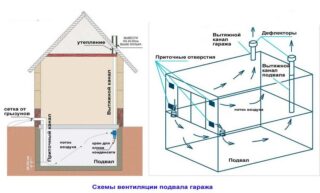A garage of any configuration needs ventilation. The supply of fresh air allows you to get rid of excess moisture, which will save the car from rusting. But if the garage has a viewing hole or basement, not only the box itself needs an extractor hood, but also the cellar.
What is ventilation in the garage cellar for?
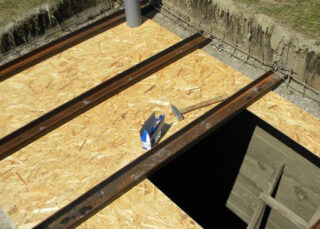
A hood in a garage with a basement is needed for several reasons:
- Without air flow, the temperature and humidity balance is disturbed. The air below becomes heavy, damp, condensation settles on the walls of the cellar.
- In such an atmosphere, vegetables and other foods stored in the cellar will begin to mold and deteriorate.
- If the basement is deep enough, a lot of dampness is also retained in the garage itself. In this case, condensation appears already on the walls of the room and on the body of the car.
- Drops of water not only provoke the development of mold. The constant action of moisture destroys the material of the walls and ceiling, the building becomes unusable much faster.
Even very good ventilation in the garage does not allow the cellar or viewing hole to be ventilated.
Types of systems and how they work
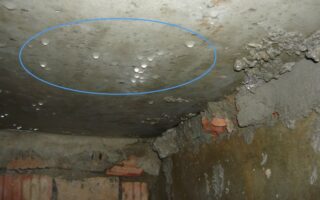
In a garage with a basement, natural or forced ventilation can be done.
Natural works due to the difference in temperature between the outside and inside air. Indoors, it is warmer, that is, more rarefied, so cold air from the street displaces it. For such a hood to work, it is enough to correctly place the openings of the supply and output pipes - not less than at a distance of 1 m from each other.
However, natural ventilation is practically useless in summer when the temperature difference is small. In areas with strong winds, it will work already due to the movement of air, but in calm warm weather it will be inactive.
With forced draft, the exhaust ducts are equipped with fans. The device forcibly expels air from the inside, thereby creating a pressure difference. Outside air flows through the supply channel on its own.
In addition to the fan, a deflector, a diffuser-vane can be installed in the ventilation. Even a heating lamp performs this role: it heats up the incoming air, creating a vacuum.
For forced ventilation to work, you need to bring electrical wiring to the garage.
Pros and cons of different types of ventilation
The advantages of natural ventilation of the cellar in the garage, installed with your own hands:
- simplicity of design;
- independence from electricity;
- good quality of work in the cold season.
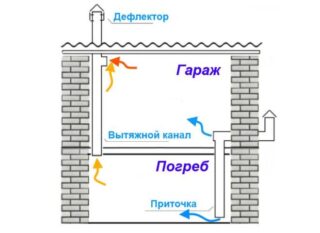
Considerable cons:
- The hood operates due to the temperature difference. If there is none - in clear warm weather, in the heat, there is no ventilation.
- Strong winds and prolonged rain will also inhibit the operation of the hood.
- To design a single ventilation, you need to take into account all the features of the room and accurately calculate the cross-section of the pipes. Otherwise, the resulting thrust will not be enough.
Forced ventilation depends little on weather conditions, this is its main advantage. There are others:
- This design is versatile and works in any room and in any conditions.
- The extraction efficiency is adjustable. You can optionally lower the temperature in the basement or drain the garage box.
- Forced ventilation eliminates condensation.
Minus one: the hood requires electricity to operate.
The choice between different types of ventilation depends on the budget, the depth and size of the basement and the prevailing weather conditions. The higher the average annual temperature in the region, the easier it is to ventilate the room only due to natural air convection.
Features of creating natural ventilation
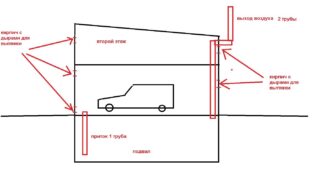
The design of a natural draft is very simple. But to create enough traction, you need to consider the following tips:
- The chimney is fixed as high as possible. It is better if the air duct goes to the roof of the building and rises 50-60 cm above the roof. In this case, the traction will be provided.
- The hood is placed along the outer wall.
- The supply pipe in the cellar is installed as low as possible - at a height of 30–40 cm from the floor. The outlet is located outside the ground level.
- The inlet must be located above the cement base.
- If shelves are installed in the cellar, it is better to put the inflow next to them.
- On average, the cross-section of pipes and boxes reaches 12-15 cm. With a large basement area, the cross-section is increased to 20 cm.
Failure to follow the recommendations for installing ventilation leads to a lack of draft.
Garage forced ventilation options
Forced from natural differs only in the presence of a device that creates traction. Most often, a fan acts in this capacity, but a deflector or a diffuser vane can also be installed.
There are 2 types of ventilation:
- Mechanical - or manual. Turns on and off manually.
- Automatic - equipped with a controller and a control panel. The hood switches on automatically. It can be programmed and turned on at certain times of the day.
The outlet pipe from the basement must be equipped with a non-return valve. This eliminates the flow of air from the street into the room.
Re-equipment of the exhaust system
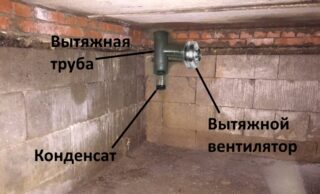
To turn natural ventilation in the cellar under the garage into forced ventilation, it is enough to install a fan. You can use both the channel version and the axial one. The first is installed in the middle of the hood or supply pipe. Axial should be mounted closer to the outlet.
The resulting system is called combined ventilation. If, when arranging a forced system, it is not necessary to strictly follow all installation rules, then in the case of a combined one, this is necessary. It differs from compulsory in that it can operate in two modes. In the cold season, when the difference between the air temperature outside and inside the basement is large, traction will be provided anyway. In summer, in calm weather, turn on the fan and thus achieve normal air circulation.
Checking ventilation for efficiency
A sign that the ventilation in the cellar under the garage is done correctly is the draft. They check it like this: in the basement, a burning match is brought to the holes of the exhaust pipe. If the flame deviates or goes out, the draft is sufficient.
You can also check the system with a sheet of thin paper. It is applied to the hole: if there is a thrust, the sheet is attracted to the pipe. If not, the paper falls.

